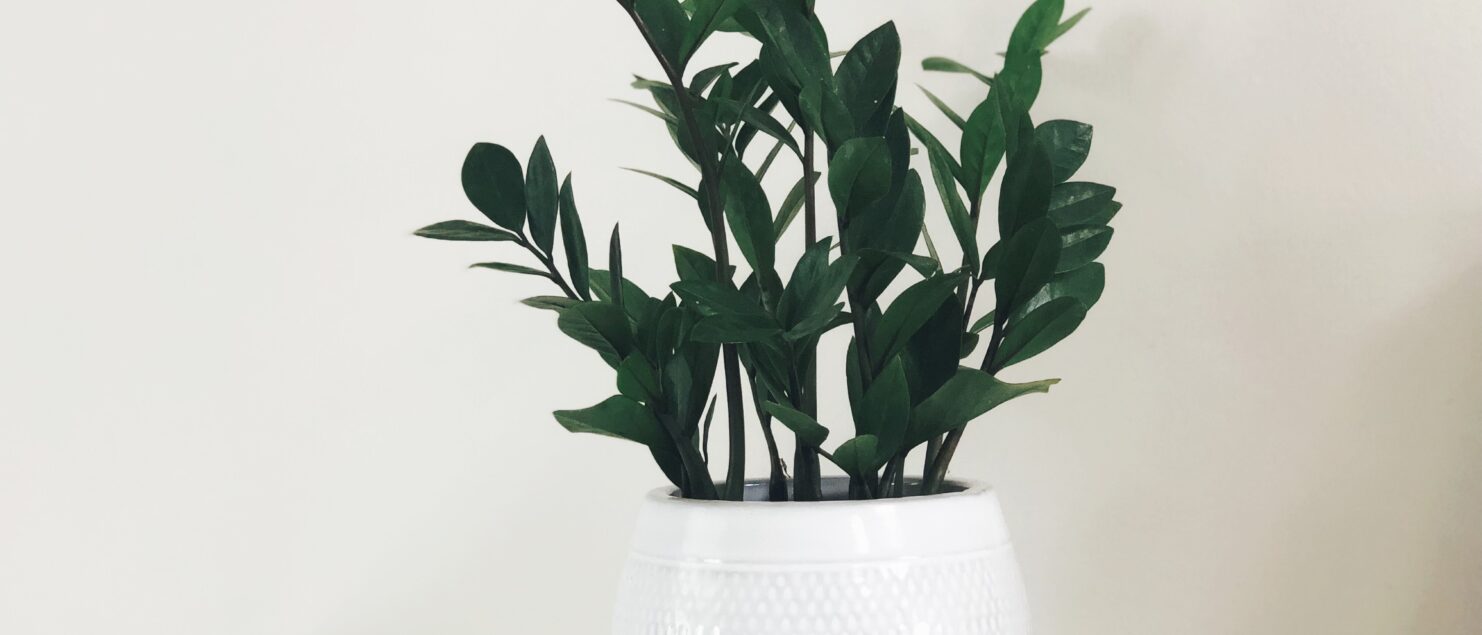Top 3 Houseplants for Beginners
Below, I’ll tell you the top 3 houseplants for beginners that I’d suggest you start with based on my own experience. All of the plants that I’ll be mentioning are ones that I had an easy time growing and keeping alive.
We’ll start off with the smallest one of the bunch and work our way up in size from there – so you can choose based on the amount of space you’re willing to give up to your new home garden.
You want to start your own home jungle?
My first pick would be…
Air Plants
Air plants are plants that are, well… basically roots. Kind of.
The roots are the plant itself, but they don’t need soil or require planting – the air around them provides everything they need.
Tillandsias come in many shapes and sizes. Most have silver-green root-like stems. Some bloom beautiful magenta and purple flowers, but when you’re shopping around, stay away from the ones in bloom.
I KNOW IT’S PRETTY!

But, unfortunately an air plant in bloom is at the end of its life. Think of that bloom like their grand finale. Once they’ve shown off their magnificent colors, they’re ready to die.
If you’ve found a young air plant to take home, caring for it couldn’t be easier which is why they were such an easy choice for my houseplants for beginners list.
They don’t like to be bothered much and only need water once a week to two weeks. They can also be found in many places; I’ve seen them in farmers’ markets, home improvement stores, and even grocery stores carry them!
Air plants are budget-friendly with an average cost of around $5 for a typical one. While some do reach $100+, those are only the very rare and hard to find ones. Stick with the cheaper ones as a beginner.
Getting Creative With Air Plants
You can do all kinds of creative things with your air plants, making them the perfect decorative piece…
Tie a string to the bottom of the base and voila! You have a jellyfish air plant.
Add it to a natural planter, such as a piece of wood, and the air plant will grow into it, making a cozy little home for itself, just like they do in the wild when clinging onto tree trunks and branches.
I have my air plants in ceramic containers – proving that they’re the perfect fit for any space. Even though they won’t form to the container as they would with wood, they’re happy, vibrant & alive!
Air Plant Tips & Tricks
Light: Low light – indirect or artificial (perfect for an office).
Watering: Every 1-2 weeks. Place air plants in room temperature water and let soak for around 10 minutes. (You can also mist them once a week in place of soaking.)
Soil: No soil necessary.
Potting: Not necessary. Tie it up with string, place it on an organic surface, or use just about any container you can think of!
Safe for pets? Yes – air plants are non-toxic to both humans and pets.
Cost: $5+
My second beginner houseplant, and medium in size goes to…
ZZ Plants
The Zanzibar Gem is truly a gem. This plant is charming with its long stems and cute oval leaves. It has a lush rich green complexion. ZZ plants can grow to huge sizes with sufficient conditions and space, but generally they are a medium-sized plant with an average height of around 2-3 inches.
The ZZ plant can withstand almost anything. I have accidently drowned it, let it dry up for over a few weeks, put it in a dark room, but nothing will knock him down.
DISCLAIMER: I wouldn’t recommend doing any of that – no matter how resilient it is.
I water mine once a week (every Sunday) and fertilize in the spring and fall. ZZ plants hate direct sunlight, so a bright room with non-direct rays is ideal for these guys. They are also great for an office space, since they can survive on artificial lighting as well.
I haven’t seen ZZ plants as widely available as air plants, but most plant shops or nurseries should have them. I’ve even spotted them in home improvement shops.
ZZ plants are not bad price-wise; they run on average $15-30.

Caring For ZZ Plants
They DO require a well-drained pot though. I will almost always plant my houseplants in cactus/succulent potting soil since it is well draining (thanks to the sand in the mixture), so that’s the potting soil I’d recommend to plant your ZZ in as well.
If you have pets or kids, make sure to keep your ZZ up high on a shelf or anywhere else that’s out of reach. ZZ plants are pretty toxic when ingested, so please be cautious in your home placement. My ZZ is on my kitchen counter out of reach from my cat that doesn’t know any better.
While toxic, ZZ plants aren’t evil. They are powerful air purifiers. They remove toxins out of the air. So even if you can’t add them to your salad, know that they got your back… and lungs.
ZZ Plant Tips & Tricks
Light: Low light – indirect or artificial (perfect for an office).
Watering: Every 1-2 weeks. I soak mine in a planter that drains easily. Soil: Any indoor potting soil will do. I use cactus/succulent soil.
Potting: Well-draining planter (make sure it has a drainage hole).
Safe for pets? No – Toxic to pets and humans. Keep out of reach of children and pets.
Cost: $15-$30.
Last but not least! My third pick on my list of plants for beginners (and the largest plant in the collection) goes to my OG plant that started it all…
Snake Plant
(Mother-in-Law’s Tongue)
If you’ve heard me talk about it before, you already know exactly how I feel about the Dracaena trifasciata. This plant was my very first plant I ever kept alive – and it’s still alive and well today!
The snake plant is one of my top three for beginners because, well… I’m the proof.
The snake plant looks like a pot filled with tall light-dark green blades. Some have yellow/white stripes or spotting. They can grow quite tall and wide – up to a foot tall. Make sure you have plenty of space for this plant.
They can be kept in smaller containers, and will maintain a smaller size, but eventually, it will get mad at you and want a bigger home.
I had roots growing out of a drainage hole of one that I wanted to keep small, so I wound up repotting her in a bigger planter. Now she is happy as can be.
These plants can be found at plant nurseries, plant shops, or a home improvement store. They range in price of $25-$100 or more depending on the size and availability.

Caring For Snake Plants
Snake plants (much like the ZZ plant) don’t require much sunlight or water. I water mine once a week, but I don’t soak it like I do with the ZZ. Try to make sure that the top few inches of soil are moist and I let them dry out over the week.
I also use cactus/succulent soil when planting my snake plants.
All my snake plants are near windows, but they don’t sit in direct light all day. They’re either placed to the side of the window or on the opposite end of the room where they don’t get much direct light.
Snake plants are also amazing at cleaning the air as well – they snatch up all the bad chemicals and dust. As a natural air purifier, they do tend to get dusty, so wipe them off every few weeks or so if you notice any dust starting to building.
Snake plants are toxic to pets and humans. Coupled with their height, these plants can be a bit tricky to find a home for. I’d recommend finding a planter that is on a stand if you’re worried about little ones reaching them.
While they do pose a risk to pets if ingested, they’re fine so long as your pet doesn’t gnaw at the blades. I have two snake plants in large planters on the floor and my cat doesn’t seem to care about them what so ever (typical cat).
Snake Plant Tips & Tricks
Light: Low to medium light – indirect or artificial (perfect for an office).
Watering: Every 1-2 weeks. Water enough to moisten the top few inches of soil.
Soil: Any indoor potting soil will do. I use cactus/succulent soil.
Potting: Well-draining planter (make sure it has a drainage hole).
Safe for pets? No – Toxic to pets and humans. Keep out of reach of children and pets.
Cost: $25-$100.
Are There Other Houseplants For Beginners?
So, there you have it, my Top 3 Houseplants for Beginners.
These are based off of my own experiences. There are many other plants for beginner depending on your climate and season. Just make sure that you do some research before you dive into finding a new plant friend. Hopefully, after a few goes with these plants you’ll be ready for more intermediate plants that require additional time and patience, like the Fiddle (or should I say “fickle”?) Leaf Fig… that’s a topic for another day. ?
But let me know what you think! Did these plants meet your expectations for a list of houseplants for beginners or were you looking for something a bit different?
Drop a comment below with your experience with these plants and come join me on Instagram to see how my collection is doing today!
Check out my video below on my Top 3 Houseplants For Beginners!
Want More Like This?
Join my email list to get the latest tips & tricks for home plant design and care!


1 Comment
Join the discussion and tell us your opinion.
Very enjoyable and informative .
Love your descriptions…I feel bad cuz I have air fern I Havnt watered….oops…didn’t think I needed to…but am going now to give the poor thing a drink!?